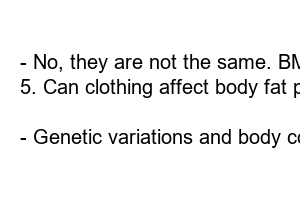체지방률 정상범위
Title: Understanding Normal Body Fat Percentage: What You Need to Know
Introduction:
As we strive for a healthy lifestyle, understanding our body fat percentage becomes crucial. **Body fat percentage** is the proportion of fat in our bodies compared to everything else, including muscles, bones, organs, and water. It is an essential metric to determine overall health and achieve fitness goals effectively.
Subheading 1: What is considered a normal body fat percentage?
A normal body fat percentage varies based on gender and age. **For men**, an ideal range lies between **10% and 20%**, while **women** tend to have a slightly higher range of **15% to 25%**. However, it’s important to remember that these percentages can also be influenced by factors such as genetics and body composition.
Subheading 2: The impact of high body fat percentage
**Higher body fat percentages** come with potential health risks. Increased fat accumulation can lead to conditions like **obesity, heart disease, diabetes, and joint problems**. It’s essential to keep body fat in check to maintain good health and prevent these health issues.
Subheading 3: The significance of low body fat percentage
While excessive body fat poses risks, **having an extremely low body fat percentage** is also not ideal. Extremely low levels can lead to **hormonal imbalances, decreased bone density, and compromised immune function**. Striking a balance is key for optimal well-being.
Subheading 4: How to determine your body fat percentage
Several methods can help gauge your body fat percentage, such as **body fat calipers**, bioelectrical impedance devices, and DEXA scans. While these techniques provide estimates, it’s best to consult with a healthcare professional or fitness expert for accuracy and guidance.
Subheading 5: Factors influencing body fat percentage
Multiple variables affect body fat percentage, including **genetics, age, sex, diet, exercise** habits, and lifestyle choices. Understanding these factors helps tailor fitness routines and dietary plans to achieve desired results effectively.
Subheading 6: Tips for maintaining a healthy body fat percentage
– Engage in regular **physical activity** to reduce fat accumulation and promote muscle growth.
– Establish a **balanced diet** rich in nutrients, emphasizing whole foods and limiting processed products.
– Prioritize **strength training** to build lean muscle, which aids in maintaining a healthy body composition.
– Stay properly **hydrated** to support various bodily functions and optimize fat metabolism.
– Seek professional guidance from a **nutritionist or personal trainer** for a personalized approach to achieve and maintain a healthy body fat percentage.
Summary:
Understanding normal body fat percentage is crucial for establishing and maintaining a healthy lifestyle. While the ideal range varies based on factors such as gender and age, both excessively high and low percentages can lead to health issues. Various methods help determine body fat percentage, and several factors influence it. By incorporating regular exercise, a balanced diet, and professional guidance, individuals can strive toward achieving and maintaining a healthy body composition.
FAQs:
1. What’s the average body fat percentage for adults?
– The average body fat percentage for men ranges between 10% and 20%, while women tend to have a slightly higher range of 15% to 25%.
2. Can body fat percentage be reduced solely through diet?
– While diet plays a significant role, incorporating regular exercise and strength training is vital for reducing body fat percentage and promoting lean muscle growth.
3. Can body fat percentage increase with age?
– Yes, as individuals age, their metabolism may slow down, and muscle mass naturally decreases, potentially leading to an increase in body fat percentage if not managed properly.
4. Is body fat percentage the same as BMI (Body Mass Index)?
– No, they are not the same. BMI considers only height and weight, while body fat percentage specifically measures the proportion of fat in the body compared to other components.
5. Can clothing affect body fat percentage measurements?
– Clothing can impact measurements taken with body fat calipers. It’s important to wear minimal clothing or opt for measurements in the same attire consistently for accurate comparisons.
6. Can body fat percentage vary based on ethnicity?
– Genetic variations and body composition differences can lead to variations in body fat percentage among different ethnicities. However, the overall concept and importance of maintaining a healthy body fat percentage remain the same for all.

